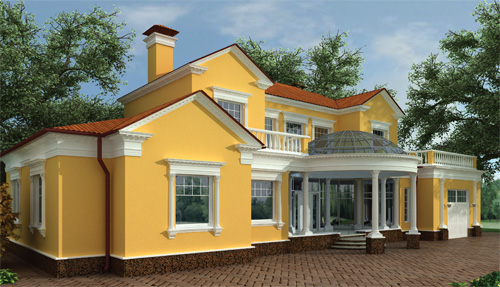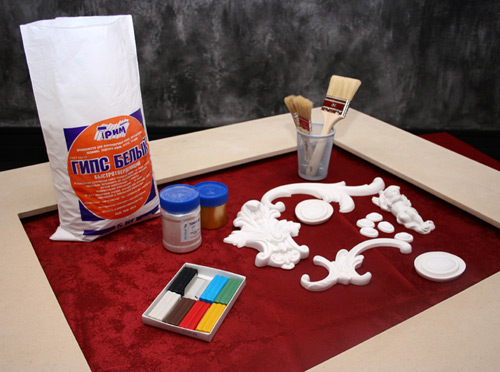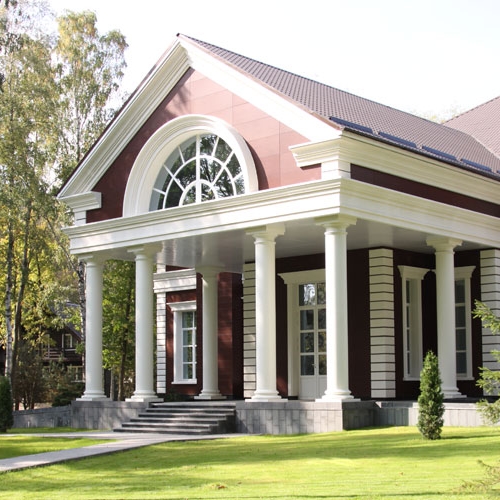When making their own home, non-standard solutions of the facade decor are especially demanding. This trend was quite rapid development due to the desire of the owners of cottages to make their home not only attractive, but also in its kind unique in relation to the architectural ensemble. Therefore, it is so popular today to the direction of decoration using the original embossed stucco.
Content
What are the forms of facade stucco?
To independently perform the project of the entire design of the outdoor building of the building in this way, initially read the possible options and the most popular forms. 
Important! This approach will make it possible to create a truly beautiful artistic facing in accordance with the rules of architecture.
Distinguish the following types of facade stucco:
Important! Select the appropriate decoring option, depending on the part of the structure you plan to decorate. For example, columns and pilasters placed through certain intervals, perfectly look at the entire surface area of \u200b\u200bthe walls. Sandriks and Arches will become an excellent solution for the arrangement of window and doorways.
Video
View video with a small overview of the most popular forms of stucco.
What makes the facade stucco?
Decorative relief design make out of the stylistic features of the architecture of the material building. Consider the volume of alleged work and our financial opportunities in order to properly arrange the facade decor, stucco in this case will be really interesting and affordable decoration, and its installation process will not bring any difficulties. 
Pay attention to those types of building materials for the decoration of the facade, the stucco of which is in high demand. These include:
- gypsum;
- polyurethane;
- styrofoam;
- glassfibrobeton;
- polymerbeton.

Important! Each of the materials listed on the list has its own advantages and has some features regarding the editing rules. Check out the recommendations below, after which make the final choice and proceed to the incarnation of your idea.

A more frequent application for today still finds facade stucco from foam, plaster and polyurethane, so the recommendations on the independent design of outer walls are applied to the use of these materials. 
Features of the creation of plaster stucco
Gypsum stucco was used to decorate various surfaces in the time of ancient civilizations. Despite the fact that the current building materials market provides a fairly wide range of species, both natural and artificial origin, gypsum enjoys unpaid demand for the design of various construction projects thanks to a number of advantages. 
Benefits of plaster decor
If you prefer the facade stucco from plaster, make sure that your choice is correct, noting the main advantages of such a material:
- Component composition exclusively from natural substances, which guarantees its harmlessness.
- Excellent strength indicators - such a stucco is preserved by centuries, without losing its attractiveness and cannot be destructed under the influence of various natural phenomena.
- Maximum pattern shape accuracy.
- High indicators of moisture resistance.
- Non-hatching.

Important! Please note that gypsum and durable and at the same time fragile material, which can be cooled with rough mechanical exposure. Therefore, during the installation process should be very neat. In addition, check before choosing a gypsum as the main material for stucco, how much the future load on the walls are valid, since after frozen, when exposed to moisture, this material is dried.
Preparation of solution and molding
To perform this work, prepare the following materials:
- silicone or plasticine forms;
- dry gypsum powder;
- water;
- colorless varnish;
- tassel;
- wooden blade;
- construction mixer or any other tool suitable for mixing the solution;
- small-grained sandpaper.

Sequence of preparation of gypsum solution and molding:
- Select the finished pattern of silicone pattern or make an independently shape of plasticine.

- If plasticine preferences, wait for drying to a complete fold.
- Treat the inner surface of the finished shape with colorless varnish.
Important! Such an approach to eliminate the adhesion of the gypsum to the surface of the shape and destruction of the finished element when removing.

- Wait for drying.
- Mix the gypsum dry mixture with water in the proportion of 0.7 liters of water per 1 kg of powder.
Important! Start the preparation of the solution immediately before the fill in the form, as the time of frozen gypsum is short.
- Stir the components to obtain a homogeneous pasta mass.
Important! Note that you can add powder into the solution, but it is impossible to top up to obtain the desired density. Otherwise, the strength characteristics of the finished frozen material will decrease.

- Apply the brush of the first layer of the solution in shape.
- Thoroughly scroll all the protrusions and depressions to ensure maximum conformity of the pattern parameters.

- Apply the following layers of the solution using the blade.
- Carefully crumple the surface after reaching the desired thickness of the decorative element.
- Wait for drying.
Important! Drying time varies from 10 to 60 minutes, depending on the chosen gypsum brand. Carefully read the instructions on the packaging.
- Gently remove the finished fragment of the future facade stucco.

- Clean the surface of fine-grained emery paper to give her smoothness.
- Paint the desired fragments into the selected shade if they decided to arrange color stucco.

- Review the video in which the entire process of self-molding of plaster is clearly shown to eliminate the emergence of any issues on technology in the process of performing work.
Rules for mounting facade stucco from gypsum
Check out the rules for fastening the plaster stucco on the facade surfaces of the house.  Very carefully do all the work in order to prevent damage to the elements during the installation process.
Very carefully do all the work in order to prevent damage to the elements during the installation process.
Progress:
- Make marking places of fastening stucco.

- Clean the surface of the walls of the facade.
- Wash the place of fastening with water.
- Wait for drying.
- On each decorative element on the back side, make notches in the form of a grid to ensure reliable clutch with the main surface.
- Scroll to the involve side of each stucco fragment.

- Wait for drying.
- Prepare the adhesive solution, mixing the gypsum mixture with joinery glue.
Important! The proportion of the composition is 3% of glue from the total weight of the adhesive solution.
- Moisten the water facade surface and the back side of the gypsum stucco fragments.

- Apply glue with a brush with a small layer on the opposite side of the stucco elements.
- Apply to the surface of the facade, slightly adding.
- Gently remove the excess glue using a spatula.
- Repeat the procedure with all the details of the decorative design.
- In the process of performing work, check the level of level level.
- Wait for drying.

Features of the design of the facade with the help of polyurethane
This material relatively recently acquired its popularity for decorating stucco. But despite this, stalling the leading positions on a par with a gypsum. 
Why is it profitable to use polyurethane forms to decorate the building?
Properly decorated polyurethane facade stucco differs in the following advantages:
- Preserving a stable light weight, regardless of the conditions of application. Such a property is ensured by the lack of moisture absorption, due to which, mostly, the details are lost.
- Reliable fastening. Polyurethane is suitable not only for decorating stone, but also wooden surfaces, which significantly expands the possibilities of its use as a facing embossed pattern of facades.
- No deformation of the created form. After a certain period of operation, all fragments from polyurethane retain their parameters, even with direct mechanical exposure.
- Wide species series of decoration models. The diversity presented on the market for all sorts of stucco stucco items allows you to choose the most interesting option, which significantly reduces the facing time and makes unprofitable independent manufacture of parts.

Important! Despite such weighty arguments in favor of polyurethane, we note that the duration of its operation is long, but still inferior to the facade stucco from the gypsum.

Decorative Elements Fastening Technology
The main stages of this process are similar to the installation of facade stucco from other materials, but there are some distinctive moments that and pay attention to:
- Prepare the surface as accuracy with the described technology.
- Make markup locations of embossed patterns.

- Mark the places of attachments with nails.
- Install a dowel in them.
- Treat the back side of the decorative fragments by sandpaper shallow abrasive paper.
- Drill in every part of the hole with the extension on the front side at a distance, exactly the corresponding rowed dowels.
- Sprount the involving and front side of each polyurethane product.

- Wait for drying.
- Hold outdoors all the details of the decorative stucco during the day.
- Apply special glue suitable for this material on the back of the stucco.
- Attach the facade to the surface.
- Wheel nails in advance prepared holes.
- Carefully seal all the joints of the joints with putty or silicone.
- Paint the decorated stucco or perform the wipping of the screws of the screws with a putty appropriate shade.
- Wait for complete drying.

Important! All installation works are performed only in warm dry weather.
Features of decorating the facade of stucco from foam
This method of cladding is the cheapest of all available options. Before paying its preference to this material, focusing exclusively for the financial side, read the rest of the benefits and disadvantages of this material to perform decorative work on the installation of volumetric stucco.
What are the advantages and disadvantages of foam for the creation of stucco?
Given enough a long list of all the advantages of foam, so that it is one, from the most sought-after building materials, we note only those that are really important when designing the facade stucco:
- Maximum light weight of all products. Such a property eliminates the need to additionally check the permissible load of the surface of the walls of the facade and greatly simplifies the entire installation procedure.
- Environmental purity. This material is though distinguished by artificial origin, but its component composition does not have any harmful effect on the human body, and also provides fireproof.

- The ability to manufacture parts of unique parameters under the order.
- Excellent strength and water-repellent characteristics.
- Compatibility with all materials that can be used to build buildings.

Important! Be sure to consider such an important nuance as the need for an additional protective layer of the foam surface to ensure its long service life under conditions of continuous impact of natural phenomena. Also, we will also take the opportunity to create details of exceptionally simple forms, without suitable patterns due to the fine-grained structure of foam.

How to install stucco stucco from polystyrene?
To correctly fasten all the stucco elements from this material, follow the work as follows:
- Carefully prepare the surface of the facade, removing all dust, various types of pollution and other facing materials.
- Climb the walls.

- Prepare the following materials:
- glue specially designed for mounting foam;
- construction studs of small diameter;
- dowel;
- primer based on quartz sand;
- paints of suitable shades;
- foam for foam for sealing seams.
- Pre-mark the sequence of installing all fragments of stucco and fasteners.

- Wheel a dowel to the surface of the wall.
Important! Make the calculation of the number of fasteners, based on the size of each individual stucco item. Focus on 2-5 pieces per item.
- Carefully check the cleanliness of the decor foam elements.
- Drill in each element of the holes under the dowel in the places of future attachments in such a way that there is no outlet on the front side.

- Prepare the glue from the dry mix in accordance with the instructions outlined on the package.
- Sequentially apply glue to the back side of each mounted fragment of the stucco.
- Follow the installation to the appropriate place with a small pressure to provide a reliable clutch with the wall surface, but do not damage the item itself.

- Get all the gaps of foam.
- Remove the remnants of spatulas.
- Wait for drying.
- Drink all the decorated stucco with a special solution.
- Color exactly with the prepared design project after drying the primer.

Conclusion
As you have seen, the design of the facade stucco does not take much time and will not require significant financial costs. But at the same time will certainly allow the entire exterior to transform and give it a special sophistication. Therefore, the result will definitely cause the admired views of the guests and the neighbors and the constant sensation of aesthetic pleasure in contemplating the building, resting after the tedious everyday life on the lawn or in the shade of trees on a plot near the house.
























